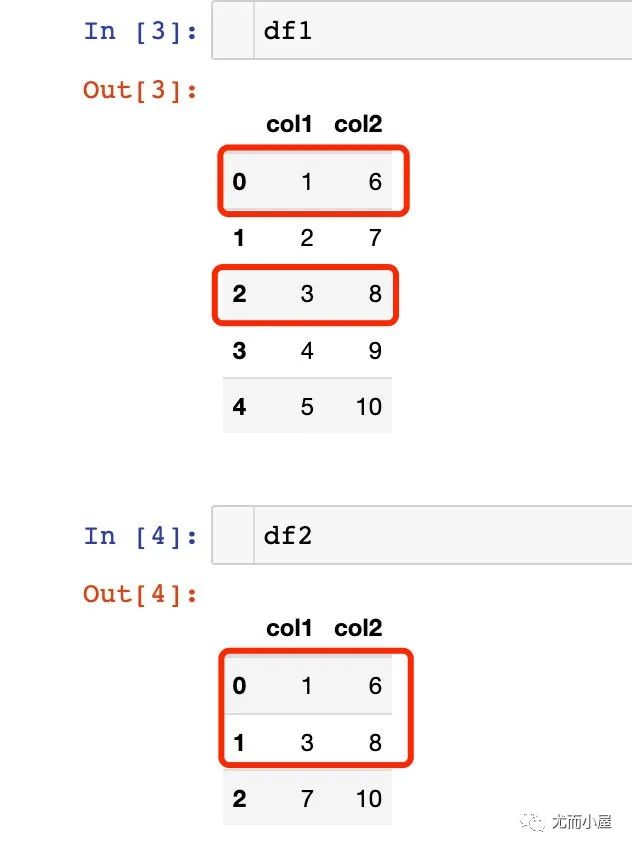Pandas DataFrame差集 交集 并集
尤而小屋 人气:0大家好,我是Peter~
本文讲解的是如何利用Pandas函数求解两个DataFrame的差集、交集、并集。
模拟数据
模拟一份简单的数据:
In [1]:
import pandas as pd
In [2]:
df1 = pd.DataFrame({"col1":[1,2,3,4,5],
"col2":[6,7,8,9,10]
})
df2 = pd.DataFrame({"col1":[1,3,7],
"col2":[6,8,10]
})
In [3]:
df1
Out[3]:
| col1 | col2 | |
|---|---|---|
| 0 | 1 | 6 |
| 1 | 2 | 7 |
| 2 | 3 | 8 |
| 3 | 4 | 9 |
| 4 | 5 | 10 |
In [4]:
df2
Out[4]:
| col1 | col2 | |
|---|---|---|
| 0 | 1 | 6 |
| 1 | 3 | 8 |
| 2 | 7 | 10 |
两个DataFrame的相同部分:

差集
方法1:concat + drop_duplicates
In [5]:
df3 = pd.concat([df1,df2]) df3
Out[5]:
| col1 | col2 | |
|---|---|---|
| 0 | 1 | 6 |
| 1 | 2 | 7 |
| 2 | 3 | 8 |
| 3 | 4 | 9 |
| 4 | 5 | 10 |
| 0 | 1 | 6 |
| 1 | 3 | 8 |
| 2 | 7 | 10 |
In [6]:
# 结果1 df3.drop_duplicates(["col1","col2"],keep=False)
Out[6]:
| col1 | col2 | |
|---|---|---|
| 1 | 2 | 7 |
| 3 | 4 | 9 |
| 4 | 5 | 10 |
| 2 | 7 | 10 |
方法2:append + drop_duplicates
In [7]:
df4 = df1.append(df2) df4
Out[7]:
| col1 | col2 | |
|---|---|---|
| 0 | 1 | 6 |
| 1 | 2 | 7 |
| 2 | 3 | 8 |
| 3 | 4 | 9 |
| 4 | 5 | 10 |
| 0 | 1 | 6 |
| 1 | 3 | 8 |
| 2 | 7 | 10 |
In [8]:
# 结果2 df4.drop_duplicates(["col1","col2"],keep=False)
Out[8]:
| col1 | col2 | |
|---|---|---|
| 1 | 2 | 7 |
| 3 | 4 | 9 |
| 4 | 5 | 10 |
| 2 | 7 | 10 |
交集
方法1:merge
In [9]:
# 结果 # 等效:df5 = pd.merge(df1, df2, how="inner") df5 = pd.merge(df1,df2) df5
Out[9]:
| col1 | col2 | |
|---|---|---|
| 0 | 1 | 6 |
| 1 | 3 | 8 |
方法2:concat + duplicated + loc
In [10]:
df6 = pd.concat([df1,df2]) df6
Out[10]:
| col1 | col2 | |
|---|---|---|
| 0 | 1 | 6 |
| 1 | 2 | 7 |
| 2 | 3 | 8 |
| 3 | 4 | 9 |
| 4 | 5 | 10 |
| 0 | 1 | 6 |
| 1 | 3 | 8 |
| 2 | 7 | 10 |
In [11]:
s = df6.duplicated(subset=['col1','col2'], keep='first') s
Out[11]:
0 False
1 False
2 False
3 False
4 False
0 True
1 True
2 False
dtype: bool
In [12]:
# 结果 df8 = df6.loc[s == True] df8
Out[12]:
| col1 | col2 | |
|---|---|---|
| 0 | 1 | 6 |
| 1 | 3 | 8 |
方法3:concat + groupby + query
In [13]:
# df6 = pd.concat([df1,df2]) df6
Out[13]:
| col1 | col2 | |
|---|---|---|
| 0 | 1 | 6 |
| 1 | 2 | 7 |
| 2 | 3 | 8 |
| 3 | 4 | 9 |
| 4 | 5 | 10 |
| 0 | 1 | 6 |
| 1 | 3 | 8 |
| 2 | 7 | 10 |
In [14]:
df9 = df6.groupby(["col1", "col2"]).size().reset_index() df9.columns = ["col1", "col2", "count"] df9
Out[14]:
| col1 | col2 | count | |
|---|---|---|---|
| 0 | 1 | 6 | 2 |
| 1 | 2 | 7 | 1 |
| 2 | 3 | 8 | 2 |
| 3 | 4 | 9 | 1 |
| 4 | 5 | 10 | 1 |
| 5 | 7 | 10 | 1 |
In [15]:
df10 = df9.query("count > 1")[["col1", "col2"]]
df10
Out[15]:
| col1 | col2 | |
|---|---|---|
| 0 | 1 | 6 |
| 2 | 3 | 8 |
并集
方法1:concat + drop_duplicates
In [16]:
df11 = pd.concat([df1,df2]) df11
Out[16]:
| col1 | col2 | |
|---|---|---|
| 0 | 1 | 6 |
| 1 | 2 | 7 |
| 2 | 3 | 8 |
| 3 | 4 | 9 |
| 4 | 5 | 10 |
| 0 | 1 | 6 |
| 1 | 3 | 8 |
| 2 | 7 | 10 |
In [17]:
# 结果 # df12 = df11.drop_duplicates(subset=["col1","col2"],keep="last") df12 = df11.drop_duplicates(subset=["col1","col2"],keep="first") df12
Out[17]:
| col1 | col2 | |
|---|---|---|
| 0 | 1 | 6 |
| 1 | 2 | 7 |
| 2 | 3 | 8 |
| 3 | 4 | 9 |
| 4 | 5 | 10 |
| 2 | 7 | 10 |
方法2:append + drop_duplicates
In [18]:
df13 = df1.append(df2) # df13.drop_duplicates(subset=["col1","col2"],keep="last") df13.drop_duplicates(subset=["col1","col2"],keep="first")
Out[18]:
| col1 | col2 | |
|---|---|---|
| 0 | 1 | 6 |
| 1 | 2 | 7 |
| 2 | 3 | 8 |
| 3 | 4 | 9 |
| 4 | 5 | 10 |
| 2 | 7 | 10 |
方法3:merge
In [19]:
pd.merge(df1,df2,how="outer")
Out[19]:
| col1 | col2 | |
|---|---|---|
| 0 | 1 | 6 |
| 1 | 2 | 7 |
| 2 | 3 | 8 |
| 3 | 4 | 9 |
| 4 | 5 | 10 |
| 5 | 7 | 10 |
加载全部内容